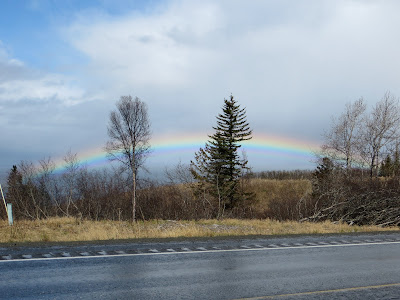9:05 PM
| Sunrise at | 4:26 AM | in direction | 37° | Northeast | |
| Sunset at | 11:11 PM | in direction | 324° | Northwest |
 |
| Mt Redoubt from the Southeast, plume barely visible behind the peak |
Iliamna is thinking about erupting and has been moved to yellow alert or watch. I was not able to find record of definitive eruptions in recorded history, but that is open to debate as several years are listed as "questionable eruption" where there appears to be smoke and ash, but without the drama of Redoubt's displays. However, right now, she is unmistakably smoking.
 |
| Mt Iliamna across Cook Inlet between Ninilchik and Anchor Point |
 |
| Looking at the peak rising to the south east of Sadie Cove |
 |
| East toward the glaciers Kenai Fjords National Park |
 |
| Looking more southerly toward Sadie Cove and Turk Bay |
 |
| The setting Sun |
The light does not linger as long in Homer as it does here and we did actually have a period of dark, plus Anne provides nice drapes for warmth and to block some of the light. I slept well. The evening before we tried to find someone available for a trip out on the bay the next day. We had wanted to go to Halibut Cove, but the restaurant was not open and would not be until Memorial Day, the start of the season for Homer. Then we looked for water taxi's or ferries going to Sedovia. The only practical way to do it was to take a ferry over and fly back. Ferries did not run as frequently and there was not much to do in Sedovia, again because the season has not yet begun.
With all of those avenues blocked, Gary opted to cocoon at the house. It was his birthday and he could think of nothing better than simply reading and resting all day. Dad and I went to the Alaska Islands and Ocean Visitors Center. Homer is the closest mainland port to Kodiak and, along with Dillingham in Bristol Bay, the closest embark point for the Aleutian Chain when traveling by sea. It is a small museum, but jam-packed with information. Displays are an interesting blend of fishing, the Aleutian Chain, wildlife preservation and the effects of the war. I was fascinated and totally lost myself exploring what it had to offer.
After, we walked down to Two Sisters along the estuary path. The Kachemak Bay Shorebird Festival was scheduled for the following weekend, but there was scant evidence of bird migrations that day. It has been a long, cold winter followed by the a long cold spring. The birds are either by-passing usual stopping points or have delayed their migration due to the slow spring. When driving along the spit the night before, we did see hundreds of sea otters off the shore, though. They seemed to enjoy the cold and turbulent waters evident in the bay that night.
Later that evening, as we settled in, we had a visitor. We agreed we had seen more moose in two days inHomer than we'd seen all month in Fairbanks. She was actively, and happily munching on the lawn and leafs around us as rain began to fall.
The rain persisted over night and then turned to snow. We went to bed with one view of Homer and woke up to another. It has been a long, cold winter followed by a long, cold spring. Leaf out was not in the immediate future for Homer.

The surprises in the weather weren't over yet. We drove home in rain, no rain, rain, no rain, sun, no sun, and then back to light rain. We were glad of the clear weather on the way down because nothing across Cook Inlet was visible on our way back north. But as we left the regions of Homer and Anchor Point, we saw this "Come back again soon" sign.
 |
| Rainbow touching the waters of the Inlet just off the bluff |


No comments:
Post a Comment
Thanks for taking time to comment.